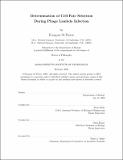| dc.contributor.advisor | Drew Endy and Chris Kaiser. | en_US |
| dc.contributor.author | St-Pierre., François, Ph. D. Massachusetts Institute of Technology | en_US |
| dc.contributor.other | Massachusetts Institute of Technology. Department of Biology. | en_US |
| dc.date.accessioned | 2014-03-19T14:18:24Z | |
| dc.date.available | 2014-03-19T14:18:24Z | |
| dc.date.copyright | 2009 | en_US |
| dc.date.issued | 2009 | en_US |
| dc.identifier.uri | http://hdl.handle.net/1721.1/85701 | |
| dc.description | Thesis: Ph. D., Massachusetts Institute of Technology, Department of Biology, 2009. | en_US |
| dc.description | This electronic version was submitted by the student author. The certified thesis is available in the Institute Archives and Special Collections. | en_US |
| dc.description | Cataloged from student-submitted PDF version of thesis. | en_US |
| dc.description | Includes bibliographical references (pages. 109-121). | en_US |
| dc.description.abstract | Bacteriophage lambda infection of Escherichia coli can result in distinct cell fate outcomes: for example, some cells lyse while others survive as lysogens. A quantitative molecular model of lambda infection supports the hypothesis that spontaneous differences in the timing of individual molecular events during lambda infection leads to variation in the selection of cell fates. Building from this analysis, the lambda lysis-lysogeny decision now serves as a paradigm for how intrinsic biomolecular noise can influence cellular behavior, drive developmental processes, and produce population heterogeneity. The aim of this thesis is to re-evaluate lambda as a paradigm for stochastic behavior by determining whether and to what extent variation in cell fate selection results from pre-existing cell-cell differences rather than chance events during infection. I find that physical differences among cells present prior to infection can control lambda developmental outcomes. Specifically, variation in cell volume at the time of infection can be used to predict cell fate: small cells tend to produce lysogens while larger cells favor lytic growth. I then present evidence that the apparent sensitivity to host volume is encoded by components of the lambda regulatory network acting upstream or at the level of CII, a critical regulator of the lambda lysis-lysogeny decision. I also detail the construction and evaluation of new strains, tools and methodology to size-fractionate populations of cells, to detect lambda infection and gene expression at the single cell level, and to enumerate individual phage particles. My results motivate further research to understand how and to what extent natural biological systems tolerate, buffer or correct for spontaneous molecular variation during development in order to produce deterministic behavior. | en_US |
| dc.description.statementofresponsibility | by François St-Pierre. | en_US |
| dc.format.extent | 121 pages | en_US |
| dc.language.iso | eng | en_US |
| dc.publisher | Massachusetts Institute of Technology | en_US |
| dc.rights | M.I.T. theses are protected by copyright. They may be viewed from this source for any purpose, but reproduction or distribution in any format is prohibited without written permission. See provided URL for inquiries about permission. | en_US |
| dc.rights.uri | http://dspace.mit.edu/handle/1721.1/7582 | en_US |
| dc.subject | Biology. | en_US |
| dc.title | Determination of cell fate selection during phage lambda Infection | en_US |
| dc.type | Thesis | en_US |
| dc.description.degree | Ph. D. | en_US |
| dc.contributor.department | Massachusetts Institute of Technology. Department of Biology | |
| dc.identifier.oclc | 872277286 | en_US |
